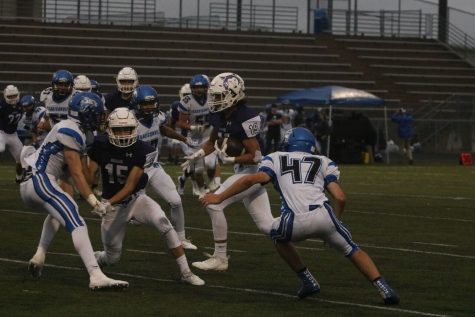The accident prone’s guide to common athletic injuries
Here are the Top 5 injuries athletes experience that keep our athletic trainer busy during the season.
Any dedicated athlete will tell you, the worst feeling in the world is being benched due to injury. Take it from someone who’s been injured frequently, there is no bigger feeling of helplessness. Reflecting on my own personal injuries, and watching a few football players this past Friday leave the field (even if only for a few drives) due to aches and pains; I began thinking of what the most common injuries for athletes are. After doing some research, I found my answers. So, without further ado, here are the top 5 most common sports injuries for athletes.
1. To start of our list we’ve got the notorious Runner’s Knee. Knee injuries comprise of over half of all sport’s injuries and just under one fourth of problems treated by surgery. While it may seem that torn ligaments and cartilage (such as the infamous ACL or meniscus tear ) would take the lead, most knee problems are grouped into the category of “runner’s knee”. Do not be fooled, this injury does not discriminate against non cross-country or track athletes. This injury typically occurs when overuse leads to irritation of the tendons below the kneecap. Replacing shoes and insoles regularly can help elude this painful experience as can running on softer surfaces.
2. Following close behind those pesky knee injuries are Shoulder Pains. A whooping 20% of athletic injuries involve the shoulder (including most dislocations, sprains, and strains). This particular problem is most common in sports that use a lot of overhead movement like baseball and tennis. Again, this problem seems to stem from overuse of these muscles and results in the loosening of the rotator cuff. Strengthening these muscles in the off season and proper stretching are the best ways to dodge any bench time with a sore shoulder.
3. It is a rare event to find an athlete that has not Sprained their ankle. This annoying injury is almost inevitable in sports that require jumping, running, and turning quickly, and is caused when the ankle twists in an unusual way leading to tenderness, swelling, and bruising. While strengthening your ankles can help, this injury is hard to prevent. The best thing to do when it happens is with the RICE concept and anti-inflammatory drugs. While you might be tempted to rest it for more than one day, the faster you get the circulation going and the swelling down, the faster you’ll be back in the game.
4. One of the most painful injuries I ever experienced was playing three months of the basketball a pretty nasty bout of Shin Splints. This injury typically refers to pain on the inner side of the shinbone that is caused by inflammation of the muscles around it. This injury is typically caused by increasing the intensity of your workout too fast, wearing worn-out shoes and jumping or running on hard ground. Ice, stretching, and lots of anti-inflammatory meds will be your best bet for minimizing the problem.
5. And ending our list for the week is possibly one of the more awkward injuries, the Groin Strain. This typically happens when sudden change in direction occurs while running. This results in sharp pain, swelling, and bruising high on the inside of the thigh. The best prevention method thus far has proved to be proper stretching and gradual increase in the intensity of a workout rather than jumping in too quickly. Speaking from experience, I can tell you this particular injury hurts doing just about anything, including trying to climb the stairs. The best way to recover is with a week of rest and ice.
If I’ve got any athletes in my audience, I can guarantee you’ve all felt the pain of at least one of these injuries. While they may not seem so serious, don’t try to muscle through them. You could end up causing more damage. Listen to your athletic trainer, do the necessary exercises and stretches, and you’ll be back in no time. No matter how wimpy you might feel complaining of groin pain, your body will thank you for the much needed rest and recuperation. And hopefully once you get back out on the court/field, it will be for good.

This blog will be home to my opinions regarding any sports related news going on both at BVNW and outside the halls of the school. Traditionally, BVNW has always upheld a standard of excellence with its athletics, so it is undeniable that sports are of great importance to the BVNW community. Sporting events are one place where everyone comes together to root for the entire school with no divisions between grades or social groups. In this blog I hope to capture that magical moment of your first home football game, the immense amount of spirit that comes from attending a boys basketball game, and much more. You can expect analysis of both our teams and their successes/failures as well as my thoughts on any other significant happening in the professional sports world.
Read more stories by Liz









